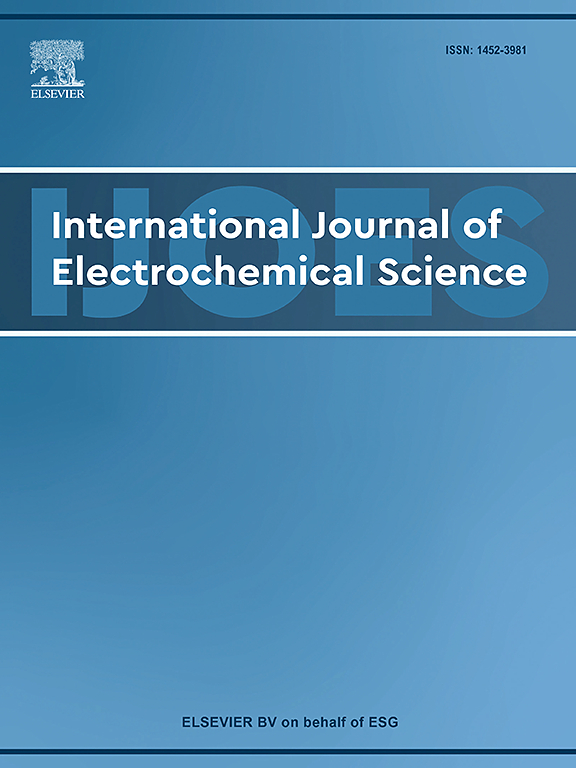Electrochemical oxidation of four pharmaceutical pollutants using Ti/IrO2 and Nb/BDD anodes: Application of factorial design methodology
IF 2.4
4区 化学
Q4 ELECTROCHEMISTRY
International Journal of Electrochemical Science
Pub Date : 2025-10-17
DOI:10.1016/j.ijoes.2025.101211
引用次数: 0
Abstract
The simultaneous oxidation of four PhCs (Carbamazepine (CBZ), Caffeine (CAF), Ibuprofen (IBU), and Diclofenac (DFC)) has been investigated by electrochemical oxidation process using Ti/IrO2 and Nb/BDD anode electrodes, respectively. The initial concentration of each PhCs was 69 µg/L. The effectiveness of the electro-oxidation process was due to its capability of oxidizing PhCs at the anode surface and in solution. A factorial experimental design was used for determining the influent parameters on the PhCs degradation. Four factors were investigated: supporting electrolyte concentration, current density, period of electrolysis and anode type. Anode type and treatment time were the most influent parameters on the electrochemical degradation of pollutants. By using a 24 factorial design, the best performance for PhCs degradation (more than 99 % of each PhC removed) was obtained by using boron doped diamond anode electrode (BDD) operated at a current density of 5.24 mA/cm2 during 70 min of period treatment time in the presence of 1.0 g Na2SO4/L. However, the period of treatment time could be five times reduced (to simultaneously remove around 100 % of each PhC) while using NaCl as supporting electrolyte (instead of Na2SO4). This was mainly attributed to the combination of direct and indirect effect of electrolysis, more effective in the case of NaCl used as supporting electrolyte compared to Na2SO4. The direct effect of electrolysis contributed to oxidize 40–80 % of PhCs (namely for DFC, IBU and CAF), whereas more than 99 % of CBZ could be oxidized owing to the sole direct effect of electrolysis.
用Ti/IrO2和Nb/BDD阳极电化学氧化四种药物污染物:析因设计方法的应用
以Ti/IrO2和Nb/BDD为阳极,研究了四种PhCs(卡马西平(CBZ)、咖啡因(CAF)、布洛芬(IBU)和双氯芬酸(DFC))在电化学氧化过程中的同时氧化反应。各PhCs初始浓度为69 µg/L。电氧化过程的有效性是由于它在阳极表面和溶液中氧化PhCs的能力。采用因子实验设计确定进水参数对PhCs降解的影响。考察了支撑电解质浓度、电流密度、电解周期和阳极类型四个因素。阳极类型和处理时间是影响污染物电化学降解的主要参数。通过24因子设计,在1.0 g Na2SO4/L的条件下,以5.24 mA/cm2的电流密度、70 min的处理时间下,掺硼金刚石阳极电极(BDD)对PhCs的降解效果最佳(每个PhC去除率超过99% %)。然而,当使用NaCl作为支撑电解质(而不是Na2SO4)时,处理时间可以缩短5倍(同时去除每种PhC约100 %)。这主要是由于电解的直接作用和间接作用的结合,以NaCl作为支撑电解质比Na2SO4更有效。电解的直接作用导致40 - 80% %的PhCs(即DFC, IBU和CAF)被氧化,而超过99 %的CBZ仅由于电解的直接作用而被氧化。
本文章由计算机程序翻译,如有差异,请以英文原文为准。
求助全文
约1分钟内获得全文
求助全文
来源期刊
CiteScore
3.00
自引率
20.00%
发文量
714
审稿时长
2.6 months
期刊介绍:
International Journal of Electrochemical Science is a peer-reviewed, open access journal that publishes original research articles, short communications as well as review articles in all areas of electrochemistry: Scope - Theoretical and Computational Electrochemistry - Processes on Electrodes - Electroanalytical Chemistry and Sensor Science - Corrosion - Electrochemical Energy Conversion and Storage - Electrochemical Engineering - Coatings - Electrochemical Synthesis - Bioelectrochemistry - Molecular Electrochemistry

 求助内容:
求助内容: 应助结果提醒方式:
应助结果提醒方式:


